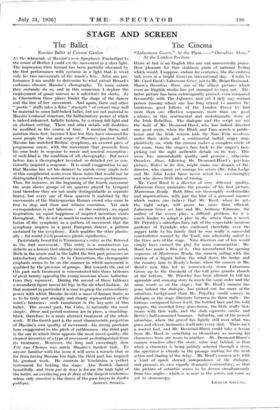The Ballet STAGE AND SCREEN
Russian Ballet at Covent Garden AT the rehearsals of Massine's new Symphonic Fantastique to the music of Berlioz I could sec the movement in a clear light. The impression then formed has been partially obscured by the first performance with costume in a light that is vivid only for two movements of the music's five. After one per- formance I am unable to determine to what extent Berard's costumes obscure Massine's choregraphy. To some extent they certainly do so, and in this connexion I deplore the employment of gauze scarves as a substitute for skirts. As in Choreartium these pieces hinder the shape of the dancer and the line of her movement. And again, these and other " poetic " stuffs (also a false "strength " of colour) may well be material to some half-baked ballet, but are not material to Massine's colossal structure, the hallucinatory power of which is indeed enhanced, balletic fashion, by a strong full light and an abstract setting. These and other details will doubtless be modified in the course of time. I mention them, and mention them first, because I fear lest they have obscured for some people the size and scope of Massine's greatest ballet. Massine has matched Berlioz' symphony, an avowed piece of programme music, with the movement that proceeds from his own body in response to music and musical conception : of such kind is the condition of all choregraphy. But never before has a choregrapher invented so detailed yet so con- sistently inspired a response. It is small exaggeration to say that Ma4sine has set his dancers to match every single note of this complicated score, even those notes that would not be distinguished by the normal car in a concert-room performance. Thus, for instance, at the beginning of the fourth movement the score shows groups of six quavers played by tympani (and therefore they are not easily distinguishable as separate beats), but every one of these quavers is matched by the movements of the Shakespearian Roman crowd who come in first to stop and stare and witness execution. Yet such correspondence is not laborious : on the contrary, an equal inspiration, an equal happiness of inspired invention exists throughOut. We do not so much in essence watch an interprer tation of the symphony as a pattern of movement that the symphony inspires in a great European dancer, a pattern sustained by the symphony. Each qualifies the other plastic- ally ; for sound itself possesses plastic significance.
Particularly beautiful is Toumanova's entry as the Beloved in the first movement. This entry is a construction (as definite as a house) that already recurs constantly in my mind. Both in the music and in the ballet the first part possesses an introductory character. As in Choreartium, the choregraphic emphasis seems to be on the manner in which movement is qualified by the presence of groups. But towards the end of this part such treatment is concentrated into three tableaux of great beauty opposing the young musician whose hallucina- tions they represent. During the second of these tableaux a recumbent figure moves his legs in the air wheel-fashion. At that moment in particular it is easy to grasp the extraordinary power with which Massine invests a mass of human limbs, so as to be truly and strongly and clearly representative of the mind's fantasies : such translation is the key-note of this ballet.. The second part, the Valse, is naturally the most simple. DEM' and period costume are in place, a stumbling- block, therefore, to a more abstract treatment of the whole work. If the fourth part is the most characteristic projection of Massine's own quality of movement—his strong precision here exaggerated to the pitch of ruthlessness—the third part is the one in which there appears the most novel quality, the clearest invention of a type of movement as distinguished from its treatment. Moreover, the long and exceedingly slow Fete aux Champs was surely Massine's hardest task. To anyone `familiar with the score it will seem a miracle that so far from taxing Massine too high, the third part has inspired his greatest work. He controls in Verchinina a perfect instrument for holding the stage. Also Zoritch danced beautifully, and their pas de deux is for me the high light of the ballet, an overlaying pas de deux of the deepest tenderness whose only ancestor is the dance of the poor lovers in Jardin






































 Previous page
Previous page